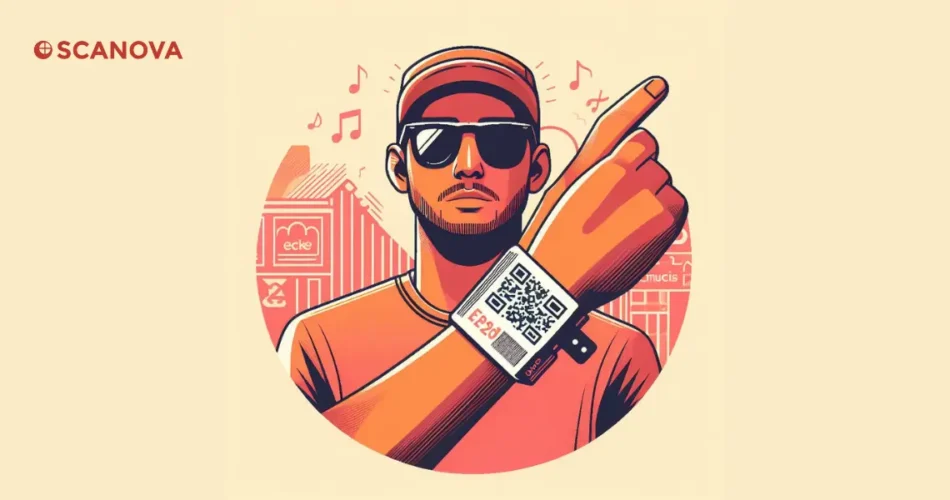In today’s digitally-driven world, integrating QR Codes has revolutionized how businesses interact with customers.
One innovative application of this technology is the Wristband QR Code, which offers numerous benefits across various industries.
Let’s delve into the advantages and diverse use cases of Wristband QR Codes but first, let us understand what they are and how they work.
A. What are wristband QR Codes
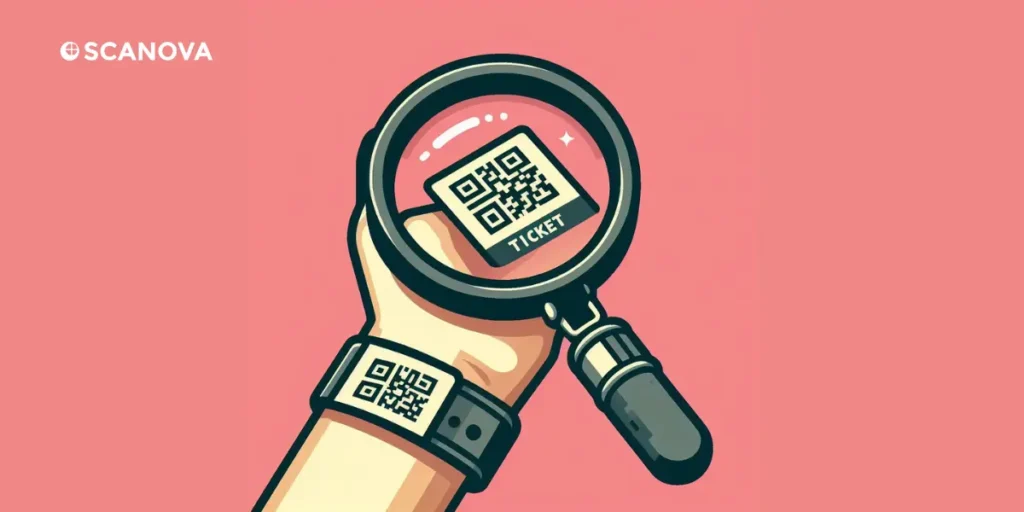
As the name suggests, Wristband QR Codes are a form of wearable technology that integrates Quick Response (QR) codes into wristbands or bracelets.
These QR Codes contain encoded information that can be scanned using a smartphone or QR Code reader.
The wristbands are typically made of materials like paper, silicone, fabric, plastic, or a mix of these and they are designed to be worn comfortably around the wrist.
Now that you know what a wristband QR Code is, you’re probably wondering what information can be encoded in these Codes.
Don’t worry we’ve all the answers to your questions, keep reading to learn more.
B. What kind of information is usually stored in wristband QR Codes
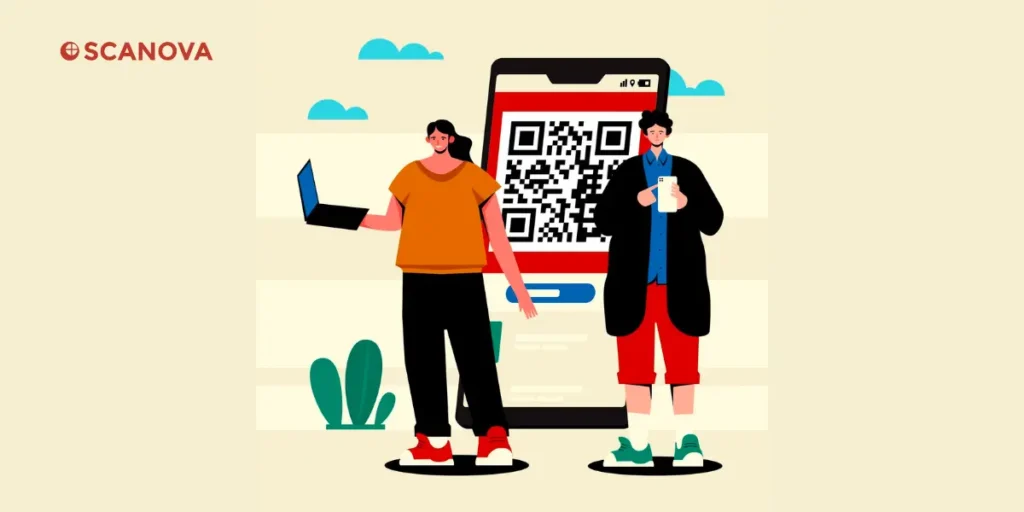
Wristband QR Codes can encode diverse information, offering versatility and functionality in various applications.
Typically, the information encoded in a wristband QR Code includes:
1. Ticketing Information: For events and venues, the QR Code can contain ticket details such as event name, date, time, seat number, and ticket type.
2. Personal Identification: QR Codes may encode personal information such as name, contact details, age, or membership status, facilitating identification and personalized interactions.
3. Payment Data: In cashless payment systems, QR Codes can store payment information linked to the attendee’s account, enabling secure and convenient transactions.
4. Healthcare Records: In medical settings, QR Codes may contain patient identifiers, medical history, allergies, and treatment information, aiding healthcare professionals in providing appropriate care.
5. Promotional Content: QR Codes can link to promotional content such as discounts, special offers, or event-related information, enhancing attendee engagement and brand exposure.
6. Access Control Credentials: QR Codes may serve as access credentials for restricted areas, granting authorized individuals entry based on encoded permissions.
Now, you’re probably wondering how a wristband QR Code works. Well, if that is the case keep reading.
C. How does wristband QR Codes work
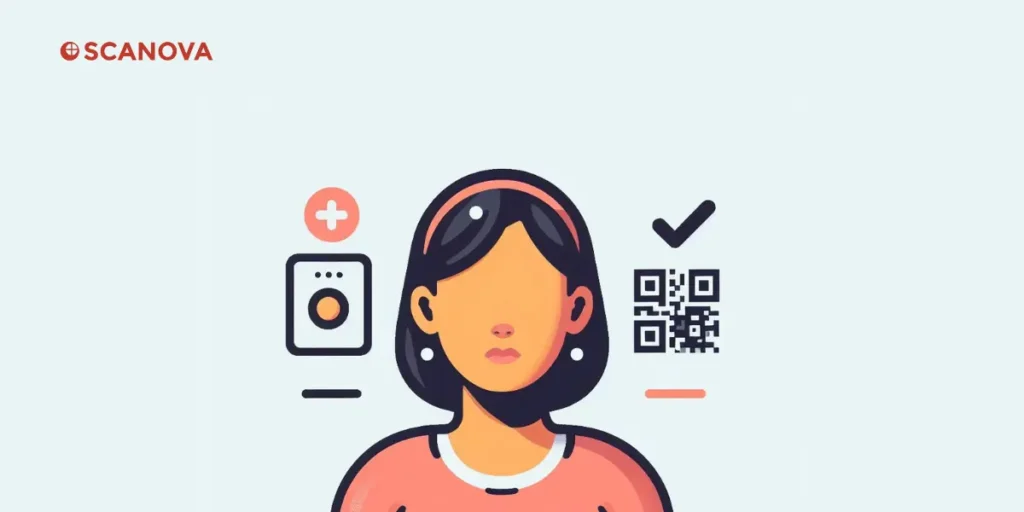
Wristband QR Codes work by embedding a Quick Response (QR) Code into a wearable wristband which is typically made of materials like silicone, fabric, or plastic.
These QR Codes contain encoded information that can be scanned using a smartphone camera or a QR Code reader app.
Here’s a detailed explanation of how these QR Codes work:
Step 1 – Generating the QR Code
The process begins with the generation of a QR Code using a QR Code maker containing the desired information.
This information can vary depending on the intended application, such as ticketing details, personal identification, payment data, or access credentials.
Read more: How to make QR Codes?
Step 2 – Encoding the wristband
Once the QR Code is generated, it is encoded onto the wristband using various methods such as printing, engraving, or embedding a QR Code sticker.
The QR Code is typically placed on the surface of the wristband in a location that is easily accessible for scanning.
Step 3 – Scanning the QR
To interact with the QR Code, a user simply needs to scan it using a smartphone equipped with a camera and a QR Code reader app.
When the smartphone camera captures the QR Code, the QR Code reader app decodes the information encoded within the QR Code.
Step 4 – Retrieving the data
Once decoded, the information stored within the QR Code is retrieved and displayed on the user’s smartphone screen.
This information can include text, website URLs, contact details, or other data, depending on what was encoded into the QR Code.
For example, if you’re using wristband QR Codes for event entry, the QR can contain information related to the event or it can contain details of the attendee.
Or, if the QR is used as an automatic patient identification (APIO) then the QR might contain details related to the patient’s medical history or their dietary guidelines, etc.
Step 4 – Initiating an action
Depending on the type of information encoded in the QR Code, the user can then take various actions or interactions.
For example, if the QR Code contains a website URL, the user can visit the website by tapping on the link displayed on their smartphone screen.
Or, if the QR Code contains payment data, the user may be prompted to complete a transaction.
Step 5 – Validation or Authorization
In some cases, the scanned QR Code may serve as a validation or authorization mechanism.
For instance, if the QR Code contains access credentials for an event or venue, scanning the QR Code at the entry point validates the user’s authorization for entry.
Step 6 – Integration with Systems
Behind the scenes, the data retrieved from the scanned QR Code may be integrated with backend systems or databases for further processing.
This integration allows seamless interaction between the user’s smartphone and the relevant systems or services associated with the wristband QR Code.
Now that you know what happens behind the scenes of these wearable QR Codes let’s take a look at their benefits.
D. Benefits of using wristband QR Codes
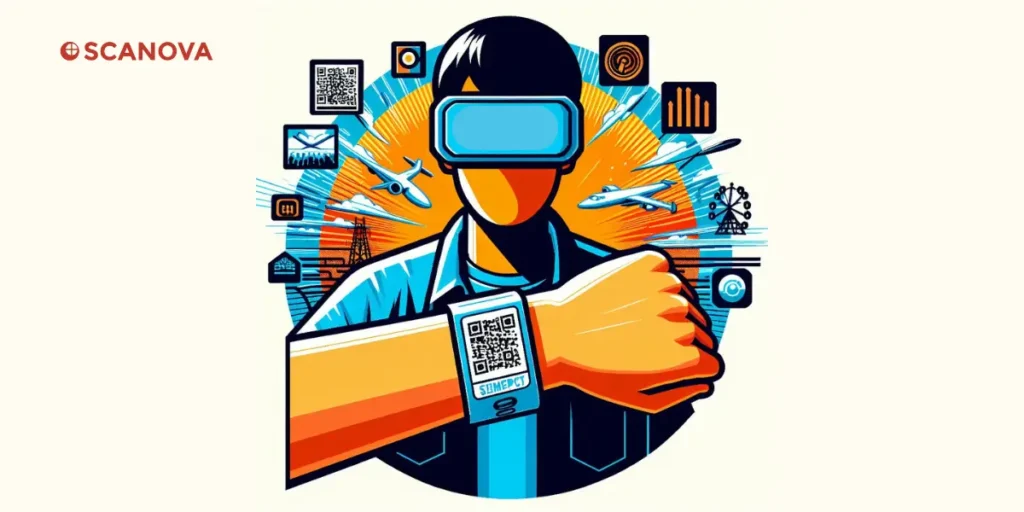
1. Enhanced convenience
Wristband QR Codes provide a hands-free solution for accessing information or making transactions.
Users can simply scan the code with their smartphones without carrying physical tickets or cards.
2. Efficient access control
These QR Codes are efficient access control mechanisms for events, concerts, or amusement parks.
Attendees can easily scan their wristband QR Codes for entry into events and conferences.
This reduces queues and enhances the overall attendee experience.
3. Customization
Wristbands can be customized with unique QR Codes tailored to specific purposes or promotions.
They can be customized to suit specific needs or preferences, such as personalized information, tailored promotions, or event-specific functionalities.
Moreover, you can personalize your wristband QR Codes to suit your brand identity better and stand out from competitors.
This customization also allows businesses to track engagement metrics and tailor marketing strategies accordingly.
4. Cost-effective solution
Compared to traditional ticketing systems or Radio Frequency Identification (RFID) technology, Wristband QR Codes offer a cost-effective alternative.
They eliminate the need for expensive hardware and can be easily integrated into existing systems.
Plus, the cost of printing these QR Codes on wristbands is minimal as compared to traditional counterparts.
5. Data tracking and analysis
Wristband QR Codes enable businesses to capture valuable data about customer behavior and preferences.
This data can be analyzed to gain insights into consumer trends and improve marketing strategies.
Here are some of the key types of data that can be tracked using these QR Codes for events:
1. Attendance Tracking: Wristband QR Codes can be scanned upon entry to track attendee numbers and monitor event attendance in real-time.
This data helps organizers manage crowd flow, anticipate peak times, and ensure compliance with venue capacity limits.
2. Entry and Exit Times: By scanning these QR Codes upon entry and exit, organizers can track the duration of attendees’ presence at the event.
This information can be useful for analyzing attendee behavior, measuring event engagement, and optimizing event scheduling.
3. Session Attendance: For multi-session events or conferences, these QRs can track attendance at specific sessions or workshops.
Organizers can use this data to evaluate session popularity, adjust room allocations, and tailor future programming based on attendee preferences.
4. Engagement with Exhibitors: QR Codes can facilitate interactions between attendees and exhibitors by enabling lead retrieval and contact exchange.
Exhibitors can scan attendees’ wristbands to capture their contact information, track booth visits, and follow up with potential leads after the event.
5. Cashless Payments: Organizers can track spending patterns if the wristbands are linked to cashless payment systems.
This data can provide valuable insights on popular vendors, and overall revenue generated from concessions, merchandise sales, and other onsite transactions.
6. Social Media Interactions: Wristband QR Codes can be integrated with social media platforms to track attendee engagement and interactions online.
Organizers can monitor hashtags, shares, and mentions related to the event, measure social media reach, and identify influencers among attendees.
7. Feedback and Surveys: QR Codes on wristbands can link to feedback forms, surveys, or polls, allowing attendees to provide input on their event experience in real-time.
Organizers can gather valuable insights, identify areas for improvement, and measure attendee satisfaction levels.
6. Durability
Wristband QR codes are often made of durable materials like silicone or plastic, making them resistant to water damage.
Unlike paper tickets, which can easily get wet and become illegible, these QR codes remain intact even in rainy or humid conditions, ensuring attendees can access the event without issues.
Paper tickets are susceptible to tearing, especially if mishandled or folded repeatedly. In contrast, these QR codes are typically tear-resistant and can withstand the rigors of everyday wear and tear.
This durability ensures that attendees can wear their wristbands throughout the event without worrying about damage or loss.


Now that you know the advantages and benefits of these wearable QR Codes, let us take a closer look at their industry-wise use cases.
E. Industry-wise use cases of Wristband QR Codes

1. Events and entertainment industry
Wristband QR Codes have become a staple in the events and entertainment industry, offering seamless ticketing solutions, access control mechanisms, and enhanced attendee experiences.
Whether it’s a music festival, sports event, or theme park, attendees can simply scan their wristbands for entry, eliminating the hassle of physical tickets and long queues.
Additionally, QR Codes facilitate cashless payments, allowing attendees to purchase conveniently while enjoying the event.
2. Hospitality sector
In the hospitality sector, wristband QR Codes are redefining guest experiences in hotels, resorts, and cruise ships.
Guests can use their wristbands for room access, amenity bookings, and personalized services.
They streamline check-in and check-out processes, minimize key card management, and enhance security measures.
These QR Codes also enable seamless integration with loyalty programs and guest feedback mechanisms, allowing hotels to provide tailored experiences and build long-term customer relationships.
3. Healthcare industry
Wristband QR Codes play a crucial role in healthcare settings, improving patient identification, medical record management, and treatment processes.
Patients wear wristbands with QR Codes containing vital information such as medical history, allergies, and medication details.
Healthcare professionals can scan these wristbands to access accurate patient data, streamline workflows, and enhance patient safety.
These codes also enable secure medication administration and help prevent medical errors.
4. Retail and marketing
Retailers are leveraging wristband QR Codes to enhance customer engagement, streamline transactions, and gather valuable consumer insights.
Wristbands with QR Codes serve as loyalty cards, allowing customers to earn rewards and discounts with each purchase.
Retailers can track customer behavior, preferences, and purchase history, enabling targeted marketing campaigns and personalized promotions.
These wearable QR Codes also facilitate contactless payments, improving checkout experiences and driving sales.
5. Education sector
Educational institutions are adopting wristband QR Codes for student identification, attendance tracking, and campus access control.
Students wear wristbands with QR Codes containing their student IDs, allowing for efficient check-in at events, classes, and facilities.
These bracelet QR Codes streamline administrative processes, reduce paperwork, and enhance campus security.
Additionally, they enable seamless integration with meal plans, library services, and campus events, enriching the overall student experience.
F. Limitations and considerations

While wristband QR Codes offer numerous advantages for events and various other applications, there are also several limitations and considerations to keep in mind:
1. Dependency on Technology: Wristband QR Codes rely on technology, including smartphones and QR Code readers.
If attendees don’t have compatible devices or encounter technical issues with scanning the codes, it could lead to disruptions and delays in accessing event services or information.
2. Internet Connectivity: Scanning QR Codes typically requires internet connectivity to access online content or complete transactions.
In areas with poor or limited network coverage, attendees may experience difficulties scanning wristband QR Codes, hindering their usability.
3. Security Risks: QR Codes contain sensitive information such as ticketing details, payment data, or personal identification.
If the QR Codes are not adequately secured or encrypted, they could be susceptible to hacking, counterfeiting, or unauthorized access, compromising attendee privacy and event security.
4. Cost of Implementation: Implementing QR Codes involves upfront costs for purchasing and encoding the wristbands, as well as integrating QR Code technology into event management systems.
Organizers must carefully consider the return on investment and budget implications before adopting wristband QR Codes for their events.
5. User Adoption and Education: Some attendees may be unfamiliar with QR Code technology or hesitant to use it due to privacy concerns or mistrust of digital payments.
Organizers should provide clear instructions and educational resources to encourage user adoption and alleviate any apprehensions about using wristband QR Codes.
6. Physical Limitations: Wristband QR Codes may not be suitable for individuals with certain physical disabilities or impairments, such as visual impairments that affect their ability to scan QR Codes using a smartphone camera.
Organizers should ensure alternative accessibility measures are available to accommodate all attendees.
7. Data Privacy Compliance: Organizers must adhere to data privacy regulations and obtain consent from attendees before collecting and processing personal information through QR Codes.
Failure to comply with privacy laws could result in legal repercussions and damage to the event’s reputation.
Since Scanova is developed by Trycon, which is GDPR compliant and is 27001:2013 certified, you can rely on it
By addressing these limitations and considerations, event organizers can effectively harness the benefits of QR Codes while mitigating potential challenges and ensuring a seamless experience for attendees.
G. FAQs: Wristband QR Codes

1. What are wristband QR Codes?
Wristband QR Codes are a form of wearable technology that integrates Quick Response (QR) codes into wristbands or bracelets.
These QR Codes contain encoded information that can be scanned using a smartphone or QR Code reader.
2. How do wristband QR Codes work?
Wristband QR Codes work by embedding a QR Code onto a wearable bracelet.
Attendees can scan the QR Code using a smartphone camera or QR Code reader app to access information, make payments, or interact with event services.
3. What information can be encoded in a wristband QR Code?
Wristband QR Codes can encode a variety of information, including ticketing details, personal identification, payment data, access credentials, promotional content, and more.
4. What are the benefits of using wristband QR Codes for events?
The benefits of using wristband QR Codes for events include:
- Streamlined ticketing and access control
- Cashless payments
- Enhanced attendee engagement
- Data capture and analytics
- Customization and branding opportunities
- Seamless integration, and scalability
5. Are wristband QR Codes secure?
Wristband QR Codes can be secure if proper measures are taken to encrypt sensitive information and protect against hacking or unauthorized access.
Organizers should implement security protocols to safeguard attendee data and ensure privacy compliance.
6. Do attendees need special equipment to scan wristband QR Codes?
No, attendees can scan wristband QR Codes using their smartphones equipped with a camera and a QR Code reader app.
QR Code scanning functionality is readily available on most modern smartphones.
7. Can wristband QR Codes be reused?
Wristband QR Codes can be reusable or disposable, depending on the event organizer’s preferences and requirements.
Reusable wristbands may be reissued for multiple events or attendees, while disposable wristbands are typically used for single-use purposes.
8. What are some potential limitations of using wristband QR Codes?
Some potential limitations of using wristband QR Codes include dependency on technology, internet connectivity issues, battery life concerns, security risks, cost of implementation, user adoption and education challenges, physical limitations, and data privacy compliance considerations.
9. Can wristband QR Codes be customized with branding or logos?
Yes, these QR Codes can be customized with event logos, sponsor messages, promotional content, and other branding elements.
Customization options vary depending on the wristband manufacturer and printing capabilities.
10. What are some creative ways to leverage wristband QR Codes for events?
Some creative ways to leverage these wearable QR Codes for events include interactive scavenger hunts, gamification elements, VIP access privileges, virtual photo booths, digital swag bags, and exclusive content unlocks.
Organizers can explore innovative ways to enhance attendee experiences and engagement using wristband QR Codes.
Conclusion
In conclusion, Wristband QR Codes offer many benefits across various industries, ranging from enhanced convenience to improved data analytics.
As businesses continue to embrace digital solutions, the versatility and efficiency of Wristband QR Codes make them a valuable asset in today’s competitive market landscape.
